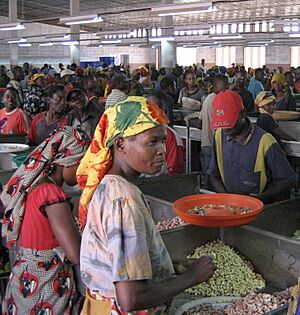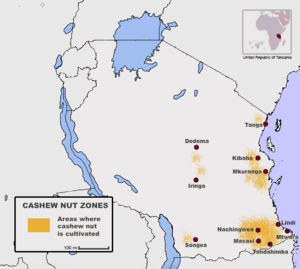Cashew production in Tanzania facts for kids
Tanzania is one of the biggest cashew nut producers in Africa. These tasty nuts bring in a lot of money for the country from other nations, about 10-15% of all foreign earnings! Tanzania is the eighth-largest cashew grower in the world and ranks fourth in Africa. In fact, it produces 20% of all cashew nuts grown in Africa. Only countries like Nigeria, Cote D'Ivoire, and Guinea-Bissau grow more.
Tanzania has been growing cashews since the 1960s, even before it became an independent country. However, there have been challenges. Sometimes, the rules for farming weren't clear, and farmers didn't always get paid on time. This made it hard for the cashew industry to grow as much as it could. For example, Guinea-Bissau, which is much smaller than Tanzania, grows a lot more cashews per area.
Most cashew farms are found in the southern coastal parts of Tanzania, near towns like Mtwara, Kilwa, and Dar es Salaam. The Cashewnut Board of Tanzania, along with farmer groups, handles the selling and marketing of the nuts. Over 90% of Tanzania's cashews are sent to India, mostly as raw nuts. This means Tanzania misses out on making more money and creating jobs by processing the nuts themselves. The Tanzanian government is working hard to find people who want to invest in cashew processing factories.
Contents
A Look Back: Cashew History in Tanzania
Cashew nuts started being grown for sale in Tanzania in the 1950s. People liked growing them because there weren't many other jobs in the southern areas, and new roads and buildings were being built. This area was also once used for a big farming project that didn't work out, called the Tanganyika groundnut scheme. Cashew production was at its highest in 1973, when farmers grew a record-breaking 145,000 tonnes of nuts!
But in the 1980s, the cashew industry almost completely stopped. The amount of cashews grown dropped to just 20,000 tonnes in 1986. This happened because the government got very involved in how cashews were harvested and sold. A program called Ujamaa encouraged farmers to grow other crops instead of cashews. Also, many people were moved to new villages, and this made some farmers leave their large cashew farms. The government also took over cashew processing factories, and since these were new to the government, they faced many difficulties.
After this big drop, the government started making changes to help the industry recover. And it worked! In just 10 years, from 1990 to 1999, cashew nut production jumped from about 29,000 tonnes to 120,000 tonnes. This brought in over $100 million for the country and made everyone excited about growing even more cashews. This growth happened because the government allowed more free trade and stopped controlling the industry so much. They also changed old laws that stopped farmers from selling raw nuts, which helped farmers earn more money. The value of the Tanzanian shilling (Tanzania's money) going down against the US dollar also made it cheaper for other countries to buy Tanzanian cashews, boosting exports. New private companies also invested, which meant farmers earned more. Plus, farmers finally started getting paid on time, which was a huge problem before and made them want to grow more nuts.
Cashew Farms and Farmers
Most cashew farmers in Tanzania are small-scale farmers, meaning they have small farms, usually about one hectare (which is about the size of two football fields). Many of these farmers are older and do most of the work by hand, without big machines. Younger people from the countryside often prefer to move to cities because cashew farming doesn't seem as exciting to them. Because there aren't many new young farmers or new investments, many cashew trees are getting old. These older trees produce fewer nuts over the years.
Where Cashews Grow in Tanzania
Tanzania has seven main areas where cashew nuts are grown:
- Dodoma: Has smaller farms.
- Iringa: Also has smaller farms.
- Lindi: Grows about 18% of the country's cashews.
- Mtwara: This is a very important area, producing 70% of Tanzania's cashews in 2011. It's in the southern part of the country.
- Pwani: Grows about 8% of the cashews.
- Ruvuma: Has smaller farms, producing about 4%.
- Tanga: Has smaller farms, producing about 1%.
Tanzania has a special advantage in the global cashew market. The harvest time for cashews in Tanzania and Mozambique is different from India and West Africa. This means Tanzanian cashews are sold when market prices are higher! Also, Tanzania grows some of the largest cashew nuts, and each farm can produce a lot of nuts per hectare. In 2010, an average farm produced over 1 tonne of cashews per hectare.
Sorting Cashew Nuts

Sorting cashew nuts has been a tricky topic for the industry. Before 1994, farmers in villages would sort the nuts into three groups: "standard" (good), "under" (okay), and "rejects" (bad). But after 1994, sorting wasn't required. Farmers, eager to get their money quickly, often skipped this step. This made the price they got for their nuts go down because buyers didn't know the quality.
Not sorting the nuts causes several problems. It makes transport more expensive and can spoil good nuts if they're mixed with bad ones. Also, it means local women, who used to get paid to sort nuts, lose out on jobs. And farmers aren't encouraged to grow high-quality nuts if they get paid the same amount no matter the quality. There's been a lot of discussion about bringing back a sorting system, maybe like the one used for coffee in Tanzania, where quality checks happen before nuts are sold.
Processing Cashew Nuts
More than 90% of Tanzania's cashew harvest is sent to India to be processed. Recently, Vietnam has also started buying Tanzanian cashews, though in smaller amounts. Tanzania currently has four main cashew processing factories:
- Hawte (in Mtwara, can process 200 tons per year)
- Korosho Africa (in Tunduru, Newala, and Mtwara, can process 2500 tons per year)
- Mohammed Enterprises (in Dar es Salaam, can process 2000 tons per year)
- Olam Tanzania Limited (in Mtwara, can process 500 tons per year)
These four factories can't process all the cashews grown in Tanzania. So, the government is interested in bringing old processing plants back to life and opening new ones. In July 2014, the former Tanzanian Prime Minister, Mizengo Pinda, announced that the government would spend $72 million to restart four processing plants in the south. These plants are in Newala, Masasi, Lindi, and Nachingwea. These new plants will help Tanzania process an extra 29,500 tonnes of cashews!
Cashew Facts and Figures
Where Tanzanian cashew nuts are exported India (83%) United States (5%) United Arab Emirates (4%) Kenya (2%) Other (6%)
Cashew nut farming in Tanzania began in the 1950s, and the biggest harvest ever was in 1972. While the country hasn't reached that level again, it's quickly getting closer!



